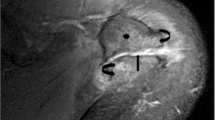Abstract
Objective
To provide an MRI timeline of normal skeletal developmental patterns in the acromial process and distal clavicle in children up to 18 years of age.
Materials and methods
Retrospective review of all shoulder MRIs obtained at our institution between January 2003 and March 2012, in children up to age 18, was performed. When available, radiographs and CT scans for these children were also reviewed. The following variables of the distal acromion and clavicle, with attention to morphology and MRI signal, were assessed: (1) Chondro-osseous junction and (2) Development and fusion of the secondary ossification centers.
Results
Ninety-eight children with 116 MR studies were identified from the data search. Of these, 13 patients were excluded and the final cohort included 85 children with 102 MRI studies. Forty-one of these patients also had shoulder radiographs. The cartilaginous precursors of the distal clavicle and acromion conformed to the final shape of these structures. The chondro-osseous interphases became progressively more lobulated and notched in the distal acromion and clavicle respectively. Appearance and fusion of the secondary ossification centers was significantly earlier in our study than previously reported. Acromial secondary ossification centers began forming at age 10 and clavicular ones, while uncommon, began forming at age 11. Fusion of acromial primary and secondary ossification centers began at age 14 and was generally complete after age 16.
Conclusions
Based on MR imaging the development and fusion of the acromion and distal clavicle in children occur earlier than previously reported. They follow a sequential pattern and can serve as a blueprint for evaluating imaging studies of pediatric shoulders.









Similar content being viewed by others
References
Caffey J. Pediatric X-ray Diagnosis. 8th ed. Chicago: Year Book Medical Publishers; 1972.
Laor T, Jaramillo D. MR imaging insights into skeletal maturation: what is normal? Radiology. 2009;250(1):28–38.
Chauvin NA, Jaimes C, Laor T, Jaramillo D. Magnetic resonance imaging of the pediatric shoulder. Magn Reson Imaging Clin N Am. 2012;20:327–47.
Nemec U, Oberleitner G, Nemec SF, et al. MRI versus radiography of acromioclavicular joint dislocation. AJR Am J Roentgenol. 2011;197(4):968–73.
Gardner E, Gray DJ. Prenatal development of the human shoulder and acromioclavicular joints. Am J Anat. 1953;92(2):219–76.
Macalister A. Notes on the acromion. J Anat Physiol. 1893;27:244–51.
Scheuer L, Black S. Developmental Juvenile Osteology. San Diego: Elsevier Academic Press; 2000.
Flecker H. Time of appearance and fusion of ossification centers. Am J Roentgenol Radium Ther. 1942;47:97–159.
Girdany BR, Golden R. Centers of ossification of the skeleton. Am J Roentgenol Radium Ther Nucl Med. 1952;68(6):922–4.
Williams PL, Bannister LH, Berry MH, et al. Gray’s Anatomy. 38th ed. New York: Churchill Livingstone; 1995.
Flecker H. Roentgenographic observations of the times of appearance of epiphyses and their fusion with the diaphysis. J Anat. 1932;67(1):118–64.
Ogden JA, Phillips SB. Radiology of postnatal skeletal development: the scapula. Skeletal Radiol. 1983;9:157–69.
Ogden JA, Conlogue GJ, Jensen J. Radiology of postnatal skeletal development: the clavicle. Skeletal Radiol. 1979;4:196–203.
McKern, TW, Stewart, TD. Skeletal age changes in young American males: analysed from the standpoint of age identification. Natick: United States Army Quartermaster Research and Development Command, 1957. p. 89–97, 111–119.
Todd TW, D’Errico J. The clavicular epiphyses. Am J Anat. 1928;41(1):25–50.
McClure JG, Raney RB. Anomalies of the scapula. Clin Orthop Relat Res. 1975;110:22–31.
Jaramillo D, Laor T, Hoffer FA, et al. Epiphyseal marrow in infancy: MR imaging. Radiology. 1991;180:809–12.
Sammarco VJ. Os acromiale: frequency, anatomy, and clinical implications. J Bone Joint Surg Am. 2000;82(3):394–400.
Gordon BH, Chew FS. Isolated acromioclavicular joint pathology in the symptomatic shoulder on magnetic resonance imaging. J Comput Assist Tomogr. 2004;28(2):215–22.
Sassmannshausen G, Wilson TC, Mair SD. Operative stabilization of an unstable os acromiale in an adolescent football player. Orthopedics. 2003;26:509–11.
Barbier O, Block D, Dezaly C, et al. Os acromiale, a cause of shoulder pain, not to be overlooked. Orthop Traumatol Surg Res. 2013;99:465–72.
Folliasson A. Un Cas D’Os Acromial. Rev Orthop. 1933;20:533–8.
Johnston PS, Paxton ES, Gordon V, et al. Os acromiale: a review and introduction of a new surgical technique for management. Orthop Clin N Am. 2013;44:635–44.
Kwong S, Kothary S, Poncinelli LL. Skeletal development of the proximal humerus in the pediatric population: MRI features. AJR Am J Roentgenol. 2014;202(2):418–25.
Conflict of interest
There are no conflicts of interest to disclose.
Author information
Authors and Affiliations
Corresponding author
Rights and permissions
About this article
Cite this article
Kothary, P., Rosenberg, Z.S. Skeletal developmental patterns in the acromial process and distal clavicle as observed by MRI. Skeletal Radiol 44, 207–215 (2015). https://doi.org/10.1007/s00256-014-2020-5
Received:
Revised:
Accepted:
Published:
Issue Date:
DOI: https://doi.org/10.1007/s00256-014-2020-5




